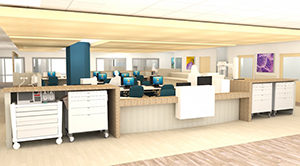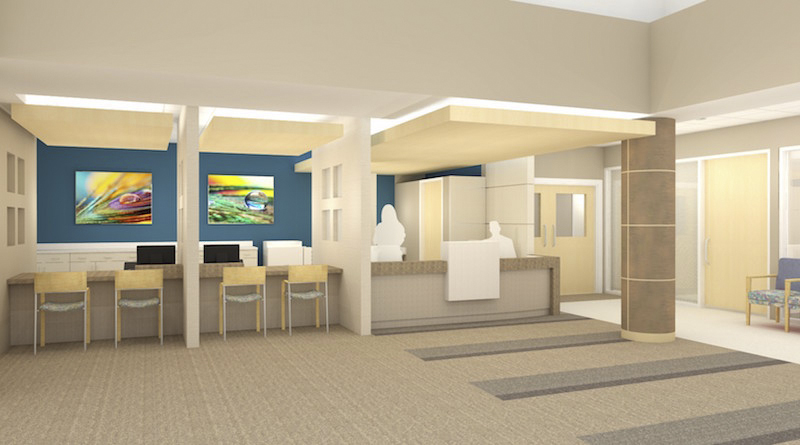Sentara Northern Virginia Medical Center Renovations Underway
By Rachel Leber
WOODBRIDGE, Va. — The Sentara Northern Virginia Medical Center in Woodbridge opened doors on Aug. 4 to the completed renovations of its emergency department (ED) lobby. With the ED lobby now completed, the rest of the department renovations that began in April are underway, with a scheduled completion date by December of this year.

Huelat Davis Healing Design in Alexandria, Va., was the architect chosen to redesign the 21,000-square-foot ED, with Scott Long Construction of Chantilly, Va., serving as the general contractor. The project has a budget of $2.6 million with a goal of providing state-of-the art space that will cater to the patient experience and patient care workflow for emergency department hospital staff. The emergency department has not been updated since 2006 when 16 rooms — eight observation rooms and eight pediatric exam rooms — were added to the floor plan. The new emergency department will have 37 rooms in total when complete.
Improvements to the emergency department will include interior design features with more “streamlined accessibility” to the intake nurse and registration teams, with the intention of patients to gain care in a quicker more efficient manner, according to Dynette Rombough, director of emergency services at the Sentara Northern Virginia Medical Center. The nurses will be placed in the front of the department, better enabling them to identify the sickest ambulatory patients upon entry. Additionally, acute care and focused care areas will also receive new updates to improve appearances and overall patient flow by decreasing the previously “fragmented feel” of the department. Due to cost, a portion of the original plan to connect two sections of the ED has been put on hold, with the hope of revisiting the improvement in future years, according to Rombough.

Photo Credit (all): Huelat Davis Healing Design
The ED design has been a team effort between all patient care entities, according to Rombough, with all items decided on “as a united front” — the impact of patient care as the central viewpoint through which decisions were made. “What makes this project special is that we took the elements back to our perspective teams for their inputs and design ideas. We involved everyone,” said Rombough.
The emergency department will continue to serve patients through the renovation process, a challenge of the project identified by Rombough and the design team. An example of meeting this challenge included redirecting the flow of emergency patients through the hospital’s main entrance while the emergency department lobby was under construction, as a measure to expedite the check-in process for the hospital while the ED lobby was under renovation.
“Continuing to offer excellent patient care while under construction is always a challenge,” said Rombough. “That said, we know this project will be worth it the end — not only to improve our work environment, but also to improve the overall patient experience. Even through the pain of construction, everyone maintained a positive attitude and outlook throughout, keeping the ultimate goal in mind. Through the new redesign of the ED intake process, we were able to develop it in conjunction with our mission and vision of ‘Improving Health Every Day.’”

